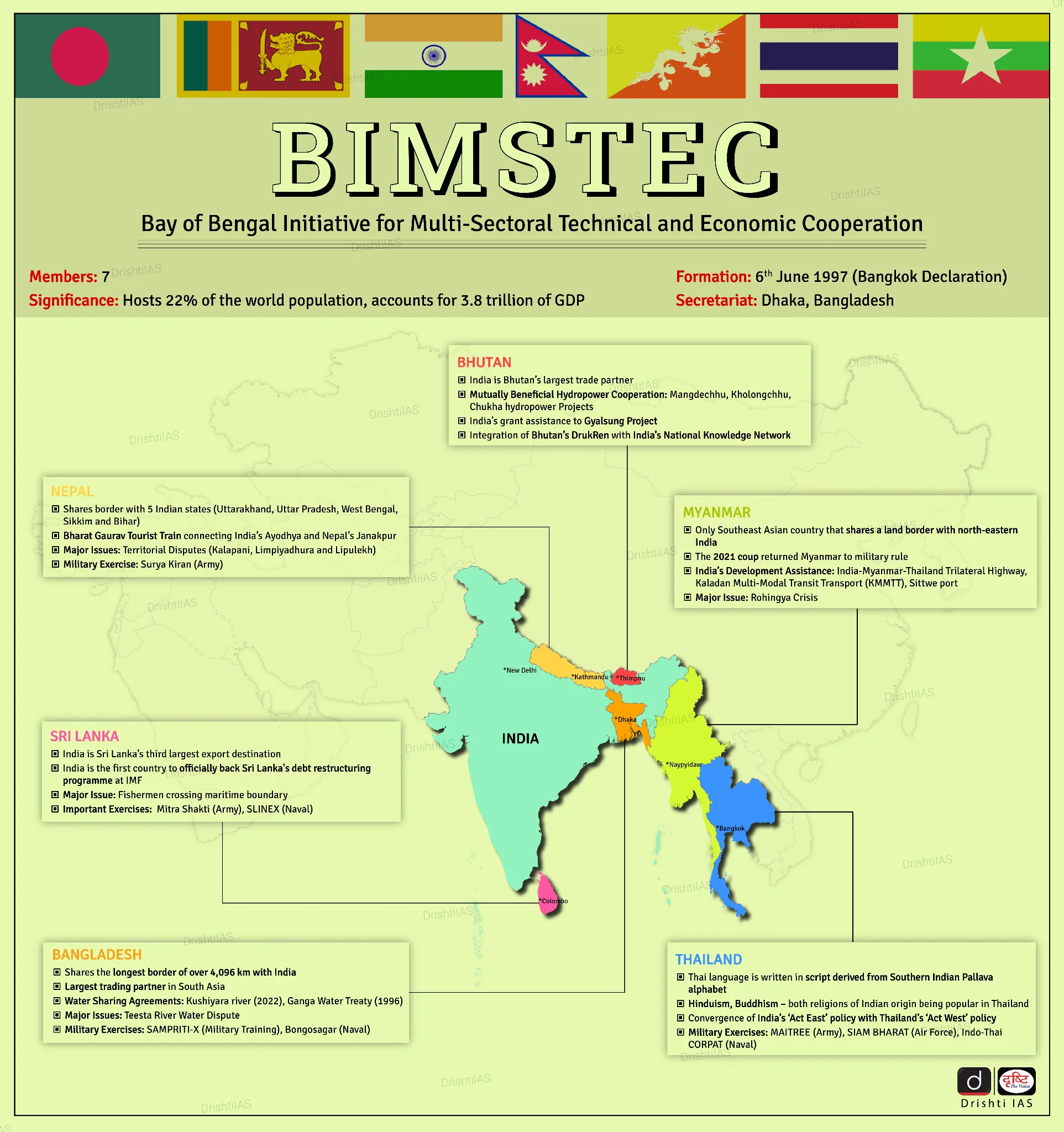Important Facts For Prelims
India Hosts 2nd BIMSTEC Ports Conclave
- 30 Jul 2025
- 5 min read
Why in News?
India hosted the 2nd BIMSTEC (Bay of Bengal Initiative for Multi-Sectoral Technical and Economic Cooperation) Ports Conclave in Visakhapatnam, to strengthen maritime connectivity, and sustainable development in the region.
BIMSTEC Ports Conclave
- Theme 2025: "Navigating the Future: Blue Economy, Innovation and Sustainable Partnerships.”
- Significance for India: Boosts India's leadership in Bay of Bengal maritime cooperation, and aligns with Sagarmala goals of port-led growth and connectivity
- It enhances India’s Indo-Pacific role through stronger BIMSTEC ties.
What are the Key Outcomes of 2nd BIMSTEC Ports Conclave?
- Push to Implement AMTC: Member countries were urged to ratify and implement the BIMSTEC Agreement on Maritime Transport Cooperation (AMTC), signed during the 6th BIMSTEC Summit (2025, Bangkok).
- The AMTC aims to boost port-led growth, enhance maritime trade and tourism, and promote skill development across BIMSTEC nations.
- Kaladan Corridor: The Kaladan Multi-Modal Transit Transport Project (KMTTP) was recognized as a strategic corridor linking India’s Northeast with the Bay of Bengal, central to India’s Act East and Neighbourhood First policies.
- The KMTTP, jointly developed by India and Myanmar, enables efficient cargo movement from India’s eastern ports to the Northeast via Myanmar.
- It includes a waterway on Myanmar’s Kaladan River from Sittwe to Paletwa, and a road from Paletwa to Zorinpui on the India-Myanmar border in Mizoram.
- KMTTP helps bypass the narrow Siliguri Corridor (or “Chicken’s Neck”), reducing transport costs and time.
- The KMTTP, jointly developed by India and Myanmar, enables efficient cargo movement from India’s eastern ports to the Northeast via Myanmar.
- BIMSTEC Sustainable Maritime Transport Centre (Mumbai): It will be launched under the Indian Ocean Centre of Excellence for Sustainable Maritime Transport (IOCE-SMarT), which will lead efforts in policy harmonisation, green transition, and digital innovation in the maritime sector.
- Cruise Tourism Potential: Conclave emphasised eco-sensitive cruise routes, and Public-Private Partnerships (PPPs) led cruise terminals to position the Bay of Bengal as a premier sustainable tourism corridor.
What is BIMSTEC?
- About: BIMSTEC is a regional organization established on 6th June 1997 through the Bangkok Declaration.
- Purpose: Promote economic and technical cooperation among Bay of Bengal countries.
- Evolution: Originally started as BIST-EC (Bangladesh, India, Sri Lanka, Thailand Economic Cooperation), the grouping became BIMST-EC after Myanmar joined in 1997. It was renamed BIMSTEC in 2004 following the inclusion of Nepal and Bhutan.
- At the 3rd BIMSTEC Summit in 2014, the BIMSTEC Secretariat was established in Dhaka, Bangladesh.
- Sectors of Cooperation: Initially six (trade, technology, energy, transport, tourism, and fisheries). In 2008, it expanded to include agriculture, public health, counter-terrorism, environment, and climate change.
- To improve coordination, the sectors were reorganized in 2021, with each member state taking the lead in specific areas.
- India leads the Security pillar in BIMSTEC, covering counter-terrorism, transnational crime, disaster management, and energy.
UPSC Civil Services Examination Previous Year Question (PYQ)
Prelims
Q. Consider the following statements in respect of BIMSTEC: (2025)
I. It is a regional organization consisting of seven member States till January 2025.
II. It came into existence with the signing of the Dhaka Declaration, 1999.
III. Bangladesh, India, Sri Lanka, Thailand and Nepal are founding member States of BIMSTEC.
IV. In BIMSTEC, the subsector of 'tourism' is being led by India.
Which of the statements given above is/are correct?
A. I and II
B. II and III
C. I and IV
D. I only
Ans: (D)







